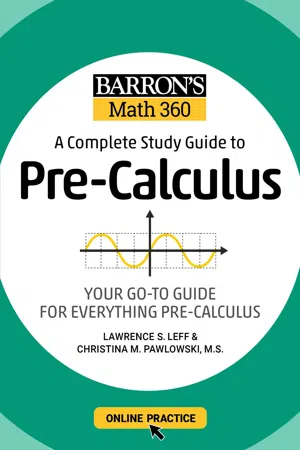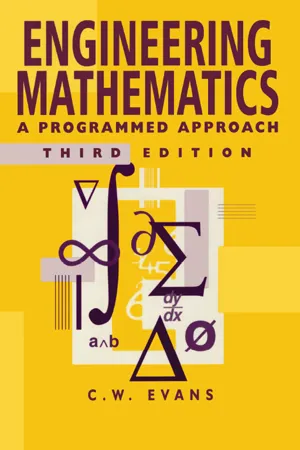Mathematics
Polar Coordinates Functions
Polar coordinates functions are a way of representing points in a plane using a distance from the origin and an angle. In polar coordinates, the distance is called the radius and the angle is called the polar angle. These functions are useful for describing circular and rotational motion, as well as for simplifying certain types of mathematical calculations.
Written by Perlego with AI-assistance
Related key terms
Related key terms
1 of 4
Related key terms
1 of 3
4 Key excerpts on "Polar Coordinates Functions"
- eBook - ePub
Fundamentals of Modern Mathematics
A Practical Review
- David B. MacNeil(Author)
- 2013(Publication Date)
- Dover Publications(Publisher)
From the table relating cylindrical and Cartesian coordinatesFrom the table z = zThus, substituting these values in the cylindrical equation78. The polar coordinate system is essentially a two-dimensional form of either the spherical polar or cylindrical system.Polar coordinates provide an alternate to the Cartesian method of designating points in the XY-plane. It has already been shown how the spherical polar system can be adapted to a two dimensional representation, i.e., ϕ was set equal to 90° and we obtained x = r cos θ; y = r sin θ; z = 0. Similarly, the same system can be derived from the cylindrical coordinate system by setting z = 0. This yields x = ρ cos θ and y = ρ sin θ.In this case ρ and r are equivalent.Thus we have the following relationships between Cartesian and polar coordinates.Example 1.Transform y2 = 8 + 4x into polar coordinatesFrom (7-14) , y = ρ sin θ and x = ρ cos θSubstituting, ρ2 sin2 θ = 8 + 4ρ cos θ.Example 2.Transform into Cartesian coordinates.Transposing, ρ(1 − sin θ) = 4Substituting from (7-14)so that .79. Hyperbolic Functions.There is one other system of coordinates to be discussed in this chapter, the bipolar coordinates. Since they are expressed in hyperbolic functions, the latter must first be explained.FIG . 7-4. Graphs of exand e−xwhich define the hyperbolic functions.The hyperbolic functions are defined as follows (See Fig. 7-4 ):Since Then,and the other hyperbolic functions may be computed from these values of sinh and cosh. In using these functions in other computations, their values are found from tables, just as are those of the trigonometric functions.In fact, the hyperbolic functions are closely related to the trigonometric functions, having the same relation to the rectangular hyperbola that the trigonometric functions do to the circle. Further relationships are obtained by recalling the expressions for series computation of the trigonometric sin and cosine, which are - Lawrence S. Leff, Christina Pawlowski-Polanish(Authors)
- 2021(Publication Date)
- Barrons Educational Services(Publisher)
STUDY UNIT IVPOLAR COORDINATES AND CONIC SECTIONSPassage contains an image
13 POLAR COORDINATES AND PARAMETRIC EQUATIONSWHAT YOU WILL LEARN
Up to now, a curve has been defined by a single equation in two variables and then graphed using rectangular coordinates. In certain situations, however, a curve may not provide a complete picture of the real-world situation it is modeling. For example, when the vertical position of a moving object is plotted against the horizontal position of the object, we can tell the position of the object from the graph, but not the time at which the object was at that position. In such situations, it is helpful to define a curve using two equations by writing x as a function of a third variable, say t, and also writing y as a function of t. The equations x = f(t) and y = g(t) define a curve parametrically in the coordinate plane.The polar coordinate system locates a point P in the plane using the ordered pair (r,θ), where the initial side of ∠θ is on the positive x-axis and its vertex, O, is fixed at the origin. The terminal side of ∠θ is the line segment OP, where r = OP, as shown in the accompanying figure.Connections between polar coordinates and graphs of complex numbers lead to relationships that allow us to find the nth roots of a complex number.LESSONS IN CHAPTER 13•Lesson 13-1: Parametric Equations•Lesson 13-2: The Polar Coordinate System•Lesson 13-3: The Polar Form of a Complex Number•Lesson 13-4: Powers and Roots of Complex NumbersLesson 13-1: Parametric Equations
KEY IDEAS
A plane curve can be described by a function that uses three variables instead of two. The extra variable, typically represented by t or θ, is called the parameter and provides additional information about the process or function represented by the curve.DEFINING A CURVE PARAMETRICALLY
Suppose that a particle is moving within the coordinate plane in such a way as to trace out the graph of y = x2 − 2x. From this function we know that at, say, x = 5, y = 15. However, we do not know from this function when the particle was at (5,15). Although the function allows us to determine the points where the particle has been, it does not tell us when- eBook - ePub
Engineering Mathematics
A Programmed Approach, 3th Edition
- C W. Evans(Author)
- 2019(Publication Date)
- Routledge(Publisher)
r ⩾ 0. Of course if we increase θ by 2π, a whole revolution, then we shall obtain the same point as before. In order to establish a unique representation we restrict θ so that 0 ⩽ θ < 2π.Fig. 3.2 The polar system.There is a minor problem when r = 0, since we then lose our one-to-one correspondence between points in the plane and ordered pairs of real numbers of the form (r, θ). For example (0, π) and (0, π/2) both correspond to the origin. One way of avoiding this problem is to insist that if r = 0 then the origin will be the unique point (0, 0): r = 0, θ = 0. However, we shall not do this as the procedure creates more difficulties than it resolves. Instead we shall avoid representing the origin and insist that r > 0.In fact the convention 0 ⩽ θ < 2π is only used occasionally in coordinate geometry. Unfortunately we shall adopt a different convention, namely –π < θ ⩽ π, when we deal with complex numbers (Chapter 10 ). The causes for this are historical and not mathematical, and this goes some way towards explaining why they are illogical.3.2 CIRCULAR FUNCTIONSIt is possible to define the circular functions cos θ and sin θ for any angle θ by using cartesian coordinate geometry and a circle centred at the origin with radius r. In Fig. 3.3 , let X be the point where the circle crosses the positive x-axis, and let the point P on the circle be such that ∠XOP = θ. If P is the point (x, y) then OP = r > 0 andcos θ =It follows immediately thatx rsin θ =y r1 If 0 < θ < π/2 then cos θ > 0 and sin θ > 0;2 If π/2 < θ < π then cos θ < 0 and sin θ > 0;Fig. 3.3 - H. Davies, H.G. Davies, G.A. Hicks(Authors)
- 2014(Publication Date)
- Routledge(Publisher)
coordinates, are required to locate a point in a plane. Two systems are used:(a) Cartesian coordinates (x , y )
This is the most commonly used system. Two perpendicular datum lines are used, the horizontal line is called the x -axis, the vertical line is called the y -axis, as shown in Fig. 9.1 . The point of intersection of the two axes is called the origin O. Any point P is located by its perpendicular distance from the two axes.Fig. 9.1(b) Polar coordinates (r , θ )
In this system a point P is located at a distance r along a line OP from a fixed point O , called the pole, as shown in Fig 9.2 . θ is the angle that the line OP makes with the reference + x -axis. It is important to remember that θ is positive when OP rotates anticlockwise.Fig. 9.2Fig. 9.3Fig. 9.3 shows the relationship between both systems. Pythagoras’s theorem and trigonometry can be used to change from one system to another.(c) Conversion from Cartesian to polar coordinates
From PythagorasandThe smallest value of θ is usually quoted and can be positive or negative. The value of θ obtained must be checked so that it places P in the correct quadrant. This can be done by using a sketch to check the results, as shown in Example 9.1 .(d) Conversion from polar to Cartesian coordinates
From Fig. 9.3 , using trigonometrical ratios in a right-angled triangle:Example 9.1 The Cartesian coordinates of a point P are (–4, –6). Convert these to polar coordinates.The point P with these two coordinates is shown in Fig. 9.4 .Fig. 9.4The value of 56.3° is not in agreement with the position of P in the third quadrant. The smallest magnitude of θ is 180 – 56.3 = 123.7°, and this is seen to be negative because it is in a clockwise direction.The polar coordinates are (7.2, –124°).Example 9.2 Convert the polar coordinates (18, 125°) to Cartesian coordinates.Fig. 9.5From Fig. 9.5 ,The Cartesian coordinates are (–10.3, 14.7).9.3 The distance between two points
Fig. 9.6 shows two points P (x 1 , y 1 ) and Q (x 2 , y 2 )Horizontal distanceFig. 9.6
Index pages curate the most relevant extracts from our library of academic textbooks. They’ve been created using an in-house natural language model (NLM), each adding context and meaning to key research topics.
Explore more topic indexes
Explore more topic indexes
1 of 6
Explore more topic indexes
1 of 4



